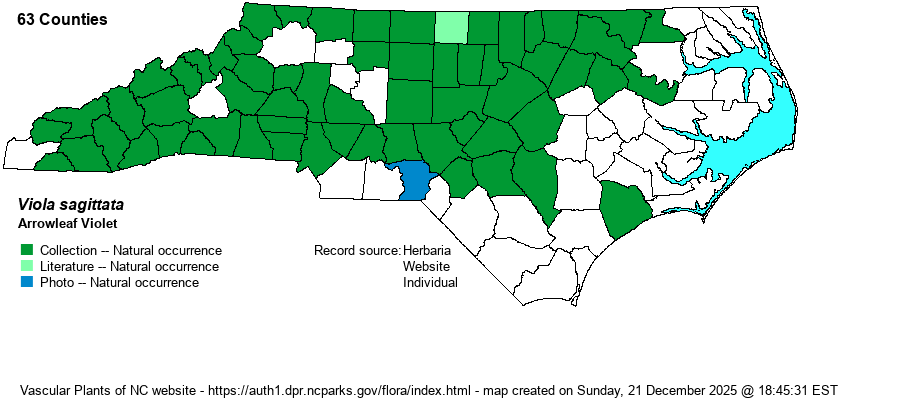| Author | Aiton | |
| Distribution | Essentially statewide, but seemingly absent from the easternmost counties; only one record known east of Hertford, Martin, and Sampson counties (for Onslow County). Note that there is some confusion between this species and V. emarginata, and some specimens of the latter might well be included on the map below. These two had been lumped into V. sagittata for a few years recently, then re-split back out by Ballard by 2024.
This is an Eastern species, ranging from eastern Canada south to GA and eastern TX. | |
| Abundance | Fairly common across the Mountains, Piedmont, and most of the western and central Coastal Plain; very rare in the eastern Coastal Plain, and seemingly absent in the far eastern counties. | |
| Habitat | This species favors moist, open ground -- wet meadows and pastures, damp edges of woods and powerline clearings, etc. However, it does grow in upland places, where sunny and open. This is a species mainly of acidic soils. | |
| Phenology | Blooms from late March into May, and fruits shortly after flowering. | |
| Identification | This is an acaulescent species, with violet-blue flowers on naked stalks, and all leaves basal and typically rather erect. The leaves are undivided, with the leaf shape oblong, often twice as long as wide; some populations contain small lateral lobes. The main separation character from the very common and widespread V. sororia and the biologically similar V. emarginata and several others is that the leaf blade is distinctly longer than wide, as opposed to almost as wide as long. Also, the tip of the leaf is drawn out and tapered, and opposed to convex and more rounded in V. sororia, V. cucullata, and V. hirsutula. Other violets grow in rich forests, wetland forests, or other habitats. | |
| Taxonomic Comments | Weakley (2018) considered it with two varieties -- var. sagittata (formerly V. sagittata and V. emarginata) and var. ovata (formerly V. fimbriatula). However, Weakley (2020) has split back out these three, as did RAB (1968) -- V. fimbriatula, an upland species of the western parts of the state; V. emarginata, an upland species somewhat statewide but more frequent in the Piedmont; and V. sagittata, a mainly wetland species of wide distribution.
General note on Viola: In 2009-10 B.A. Sorrie (website map editor) went through the whole collection at NCU, annotating all specimens against those verified by experts in the genus. The range maps in RAB (1968) have been changed accordingly. More recently, Harvey Ballard and colleagues are in the process of revising all Eastern and Southeastern Viola, and have annotated all specimens at NCU in July 2024. They recognize additional species not in RAB or in previous editions of Weakley et al.; we will follow updated editions of Weakley et al. in recognizing them. Species range maps have been adjusted to account for identification changes. | |
| Other Common Name(s) | Arrowhead Violet | |
| State Rank | S5 * | |
| Global Rank | G5 | |
| State Status | | |
| US Status | | |
| USACE-agcp | FACW link |
| USACE-emp | FAC link |

